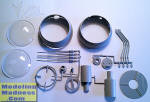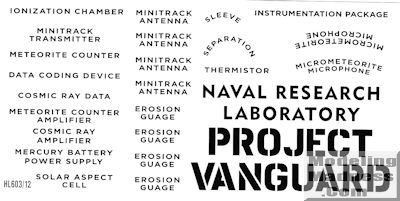
Hawk 1/5 Vanguard Satellite
| KIT #: | HL 603/12 |
| PRICE: | $21.99 |
| DECALS: | One option |
| REVIEWER: | Les Dorr Jr. |
| NOTES: | Round 2 reissue of 1958 kit |

| HISTORY |
Space Race!
In those heady days nearly six decades ago, space
fever had seized a sizable portion of the American public. Partly it was fueled
by TV space operas such as Space Patrol
and Tom Corbett, Space Cadet, along
with science-oriented shows like Disney's three-part space series. Perhaps even
more, there was a keen desire to surpass those godless Commies who had staked
out the orbital high ground with the launch of Sputnik 1 and 2 in late 1957.
The United States had its own earth satellite
programs. The U.S. Army's effort, led by Werner von Braun, focused on using a
modified Redstone missile called the Jupiter-C as a launch vehicle. The Navy's
contribution was the Vanguard booster derived from the quasi-civilian Viking
sounding rocket, while the Naval Research Laboratory built the Vanguard
satellite itself. The Eisenhower Administration preferred Vanguard, in part
because it didn't have the Jupiter-C's military heritage.
The “standard” Vanguard satellite was an aluminum
sphere 20 inches in diameter, into which experiments could be mounted. There
also was a much smaller “minimum” Vanguard satellite--often compared to a
“grapefruit”--about six inches in diameter.
The Vanguard project was not very productive, as
space historian and modeler Mat Irvine explains in the instruction sheet: “Only
three of the 11 Vanguard orbital rocket launches were successful. After there
had been two launch failures, Vanguard 1 achieved orbit on March 17, 1958, on
board Vanguard TV-4, becoming America's second artificial satellite, after
Explorer 1 (January 31, 1958.)”
Mat also notes that the Hawk model is almost an exact
match for the Vanguard standard satellite launched April 28, 1958, which failed
to make it into orbit.
| THE KIT |

 r
flash despite the kit's antiquity. The kit is designed to build up into an
“educational” display, with an experiment package and supporting hardware
inside. The decal sheet has labels for the interior experiments and several
pieces of exterior equipment.
r
flash despite the kit's antiquity. The kit is designed to build up into an
“educational” display, with an experiment package and supporting hardware
inside. The decal sheet has labels for the interior experiments and several
pieces of exterior equipment.
The pictorial instructions are easy to follow, with extensive color callouts and a decal placement diagram. Note that the colors given for the exterior satellite shell are either gold or silver, but the real deal was bright aluminum.
| CONCLUSIONS |
June 2015
If you would like your product reviewed fairly and fairly quickly, please contact the editor or see other details in the Note to Contributors.